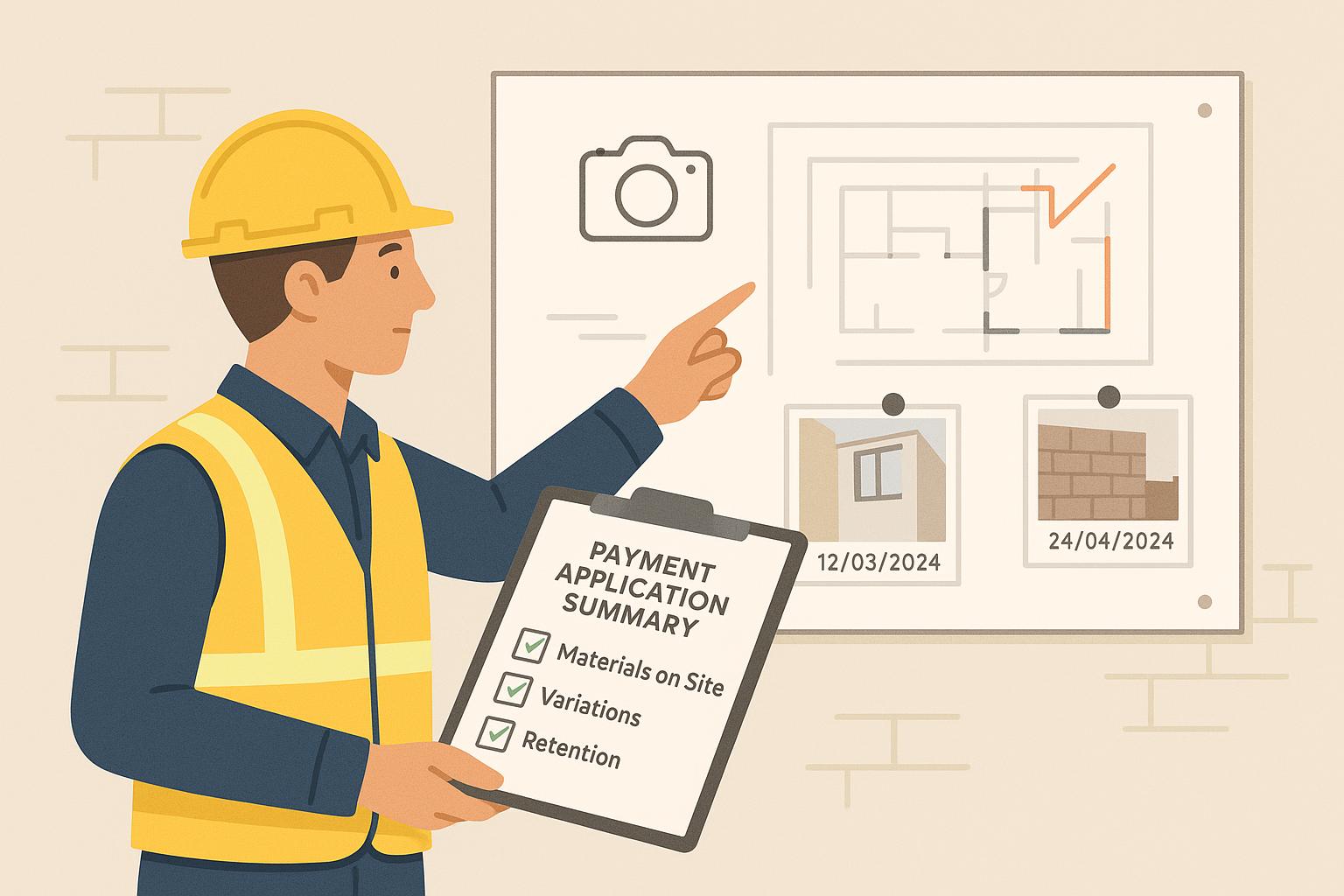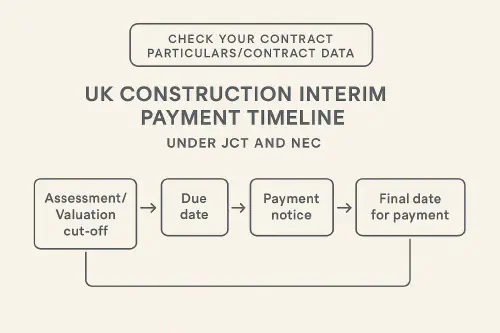
Interim valuation evidence pack: photos, paperwork and timeline (JCT and NEC)
Interim valuation evidence pack: photos, paperwork and timeline (JCT and NEC)
Contents
- Who this is for
- Quick answer
- What to include in your evidence pack
- Photo proof that stands up
- JCT vs NEC payment timeline explained
- Simple workflow you can copy
- Templates and internal links
- FAQ

Site manager compiling an interim valuation evidence pack with date-stamped photos and a checklist
Who this is for
UK construction owners, QSs and project leads who need clean, defensible interim valuations and applications for payment on building, fit-out and M&E jobs. You’ll get a practical checklist, a photo protocol, and a simple timeline for JCT and NEC contracts.
External references you can cite in conversations with clients and CAs/PMs:
- RICS Black Book: interim valuations and payment PDF
- Designing Buildings Wiki overview of valuation of interim payments
- JCT explains interim payments
Quick answer
To get paid on time and avoid disputes, your application needs three things:
- Evidence pack that tells a clear story: measured work, photos tied to items, delivery and test certs, and a simple summary “gross to date, less previous, equals this period”.
- Dates right: align to the contract’s assessment/valuation date, due date, payment notice window and pay less notice deadline.
- Consistency month to month: repeatable viewpoints for photos, the same naming for files, and a running take-off log.
Do those three and most valuation arguments disappear.
What to include in your evidence pack
Think like an auditor. Could someone match each pound you’re claiming to a measured quantity and a photo or document? Build your pack in this order:
- Cover sheet and totals
- Gross to date, less previous, equals this period
- Variations/compensation events, prelims, retention, VAT
- Measured work
- Marked-up drawings and take-off sheets (NRM2/SMM7 basis or activity schedule progress)
- Remeasure logs and count sheets
- Variations and change
- Instruction numbers, scope summaries, rates/build-ups and status
- Materials on site
- Delivery notes, storage photos, batch/serial numbers, QA certificates
- Off-site materials (if allowed)
- Vesting certificate/title transfer, insurance, storage photos at supplier
- QA and testing
- ITP sign-offs, test results, commissioning records
- Dayworks (if applicable)
- Signed sheets with before/after photos
- Notices and records
- RFIs, CVIs/AIs, Early Warnings (NEC), site diary extracts
Example pack structure
| Section | What it proves | What to attach |
|---|---|---|
| Summary | Basis of payment and totals | 1-page summary PDF |
| Measured work | Quantities and percent complete | Redlined drawings, take-off log |
| Variations/CEs | Scope and valuation basis | Instruction list, build-ups |
| Materials on site | Title, quantity, condition | Delivery notes, storage photos |
| Off-site materials | Title transfer and insurance | Vesting cert, supplier photos |
| QA/Testing | Compliance | Test certs, ITPs, commissioning |
| Dayworks | Time and materials | Signed daywork sheets, photos |
Photo proof that stands up
Use a simple, repeatable protocol. You don’t need an expensive app, but you do need discipline.
- Viewpoints: set fixed viewpoints per area so progress is comparable each month.
- Four shots per claim item:
- Context wide shot (location and orientation)
- Mid-shot of the element
- Close-up with scale (tape/level/staff) for quantity or quality
- Concealed works before cover-up (rebar, fixings, depths, services)
- In-frame tag: small whiteboard or paper tag showing Job, Grid/Level/Room, BoQ/WBS item, date, Photo ID.
- File naming: P123_B1_L02_GD-E3_Blockwork_20250925_014
- Link photos to lines: reference Photo IDs against each BoQ/Activity line in your schedule.
- Materials: photograph labels, batch numbers and storage conditions on delivery. For off-site stocks, take periodic dated photos at the supplier.
Helpful internal reads:
- AI site diaries from photos and voice notes: Build an AI site diary from photos and voice notes: compliant records without the paperwork
- Construction site diary template: Construction site diary template: what to include, examples and a fast digital setup
JCT vs NEC payment timeline explained
The dates come from your executed contract. Always check your Contract Particulars (JCT) or Contract Data (NEC). Typical flow:

Flowchart of interim payment timeline: valuation cut-off, due date, payment notice, pay less notice, final date for payment
- Assessment/valuation cut-off: measure work done to date.
- Due date: triggers the statutory payment cycle.
- Payment notice: payer/CA/PM states the sum considered due and the basis.
- Pay less notice: if the payer intends to pay less, they must serve this before the deadline.
- Final date for payment: when funds must land.
Useful overviews:
- MJD Solicitors on JCT due dates and Interim Valuation Date
- Designing Buildings Wiki on interim certificates
Simple workflow you can copy
Tools: Google Drive or OneDrive for storage, a shared Google Sheet for the photo log, and your existing job management or costing tool.
- Before month end
- Walk the job with your take-off and repeatable photo viewpoints. Capture four shots per item and any deliveries/testing.
- Update the running take-off log and redline drawings as you go.
- Build the pack
- Save photos to a dated folder: Project/Valuation-YYYY-MM.
- Complete your photo log (Photo ID, date, location, BoQ item, qty evidenced, drawing ref, remarks).
- Export a PDF of redlined drawings and the take-off summary.
- Collate delivery notes, test certs and any dayworks.
- Draft the application
- Create the summary page: gross to date, less previous, equals this period; show retention and VAT.
- Add detailed schedules with photo IDs and drawing refs next to each line.
- For variations/NEC CEs, include instruction numbers, basis of valuation and status.
- Submit and track
- Send the application before the assessment date where your contract allows your application to stand as the default notice.
- Calendar the payment notice and pay less notice deadlines, and the final date for payment.
- If queried, reply with a screenshot of the relevant line, the photo thumbnail and the drawing snippet. Keep it factual.
Optional upgrades
- Use 360-degree walkthroughs or drone orthos monthly for quick progress capture.
- If you’re often challenged on evidence, adopt a photo app that preserves EXIF metadata and hashes originals.
Quick training tip for your team
Print a one-page photo protocol and put it in the site induction pack. Do a 10-minute toolbox talk before each valuation week to refresh the habit.
Templates and internal links
- Want a ready-made site diary and photo workflow? See: Construction site diary template: what to include, examples and a fast digital setup
- Sorting deposits and staged payments with clients? Read: Deposits, staged payments and progress invoices for building jobs: what’s normal and how to set it up
Short video explainer
Interim valuation process explained (Metroun Quantity Surveying)
FAQ
What exactly should be on the one-page summary?
Gross to date, less previous, equals this period, plus or minus variations/CEs, prelims and retention, then VAT. Also state the valuation period and cut-off date.
Can I claim off-site materials?
Only if your contract allows it and you have the paperwork: vesting certificate/title transfer, insurance, storage details and dated photos at the supplier. Otherwise, leave them out until compliant.
How do I show percent complete without arguments?
Measure wherever possible. Use counts, lengths or areas tied to drawings with in-frame scale photos. For activity schedules, define objective milestones and show the evidence for each milestone.
What’s different between JCT and NEC for payments?
JCT uses due dates and payment/pay less notices managed by the Contract Administrator/Employer’s Agent. NEC uses assessment dates and the Project Manager assesses the amount due (PWDD). UK payment law still applies, so there will be statutory payment notic…